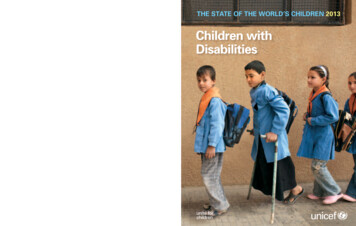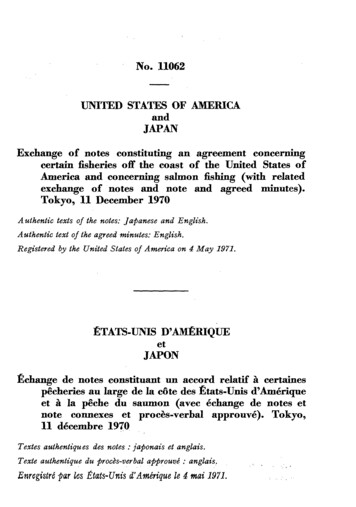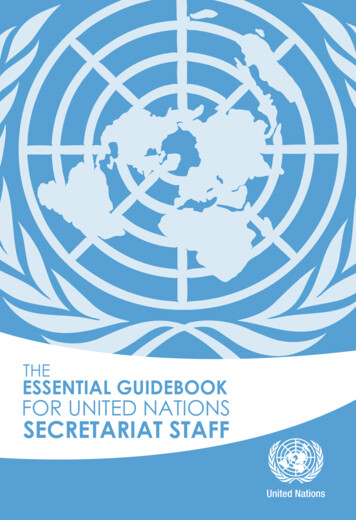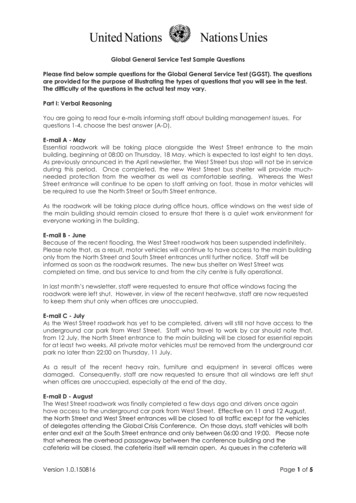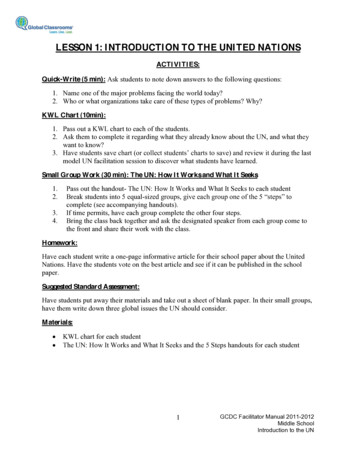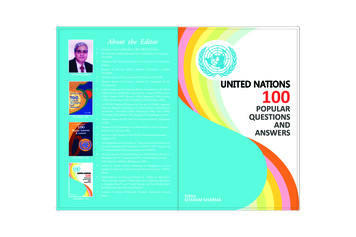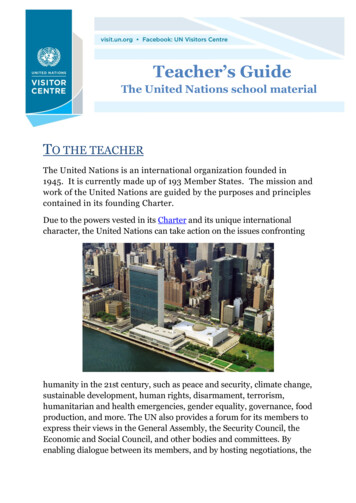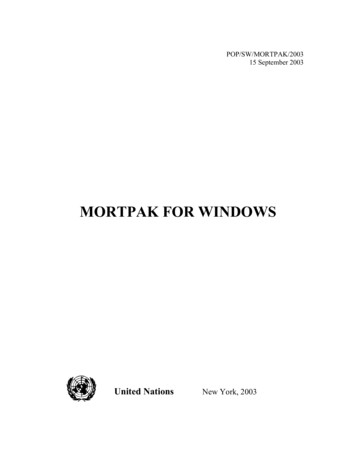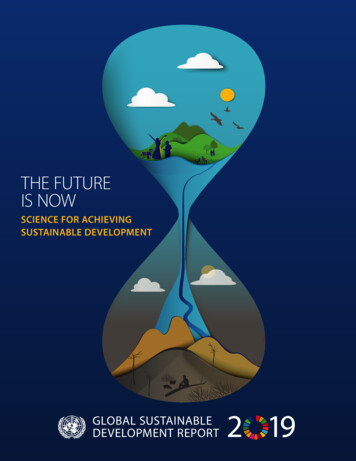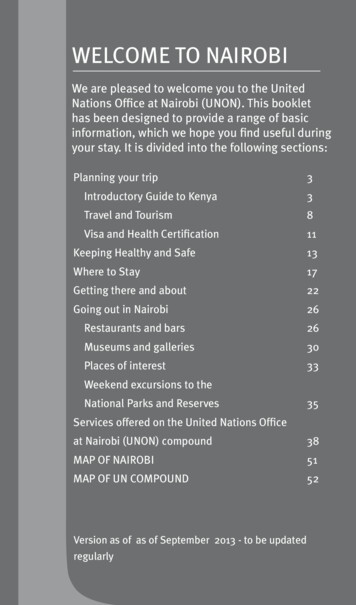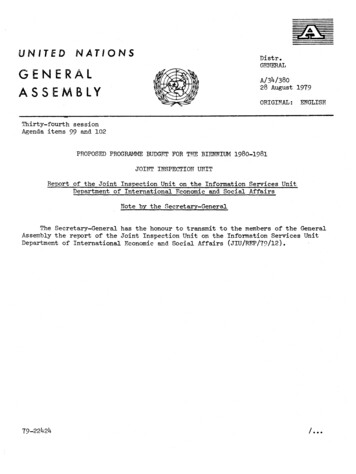
Transcription
8 August 1979ORIGINAL:ENGLISHThirty-fourth sessionAgenda items 99 and 102PROPOSED PROGRAMME BUDGET FOR THEJOI TTBI TIUM1980-1981INSPECTION U1TITReport of the Joint Inspection Unit on the Information Services UnitDepartment of International Economic and Social AffairsNote by the Secretary-GeneralThe Secretary-General has the honour to transmit to the members of the GeneralAssembly the report of the Joint Inspection Unit on the Information Services UnitDepartment of International Economic and Social Affairs (JIU/REP/79/12).79-22424/ .
JIu/BEP!79!12REPORt'ON THE INFOlIQTION SERV'ICES UNITDEPARTMENT OF INTERNATIONAL ECONOMIC AND S: CIAL AFFAIRSPrepared byMark E. AllenandEarl D. SohmJoint Inspection UnitGenevaJune 1979GE.79-2358
Table of ContentsParagraphSUMMARY(including principal conclusionsand recommendations)CHAPTER IHistorical backgrotmdCHAPTER IICurrent situation11-13CHAPTER IIIThe main issues14-28CHAPTER IVConclusions29-301-10Page
SUMMARY(including principal conclusions and recommendations)The chief purpose of the proposed Information Services Unit (ISU) is tomake available, through a computerized information system, information contained in unpublished documents in the Department of International Economicand Social Affairs and the Department of Technical Co-operation.Theproposal has been before the General Assembly since 1976 and has also beenconsidered·by the Committee for Programme and Co-ordination and the AdvisoryCommittee on Administrative and Budgetary Questions.The General Assemblyhas called for a wide-ranging report on the matter, taking into account,inter alia, the conclusions and recommendations of the Joint Inspection Unit.The present study incorporates these conclusions and recommendations.TheInspectors express their thanks to all who helped them in their task (paragraphs 1-10).The Unit has been set up in the Department of International EConomicand Social Affairs on a provisional basis, and is now entering documentsin a pilot data base with a view to the incorporation of the proposed information system.as a sub-system of UNBIS, the system developed for theDag Hammarskjold Library.The pilot data base will be open to enquiriesfrom the latter part of 1979 (paragraphs ll-13).The Inspectors consider that the need, or otherwise, for the proposedsystem can only be demonstrated after a period of use.They recommend thatit should be tried out for a period approaching one year, and that inconsequence the Assembly should take its final decision on the continuanceof the Unit in 1980 (paragraphs 14-20).It appears that the annual direct costs of the Unit would come to about 250,000 (paragraph 21).On the question of compatibility with UNBIS and other systems, theInspectors point out that the MINISIS-based system of ISU is fully compatiblewith .a number of other systems, and that technical measures can pe taken, ata certain cost, to make it compatible with UNBIS.They recommend tha.t theInter-Qrganization Board for Information Systems should review the proposedsystem (paragraphs 23-26).The Inspectors underline the importance of co-operation between ISU andthe Electronic Data Processing and Information Systems Service and also theDepartment of Tech.'1ical Co-operation (pa.ragraphs 27-28).
Chapter IHISTORICAL BACKGROUND1.The proposal to create an Information Services Unit (ISU) within theformer Department of Economic and Social Affairs (DESA) appears to haveoriginated in the Department towards the end of 1975, and it was proposedas part of interdivisional sub-programme 2 in the Medium-Term Plan for1978-81.Its purpose was at that time seen as "to improve the informationavailable to Member States, the Department of Economic and Social Affairs,the regional commissions, field experts and others, by making the existinginformation in the DESA and the regional commissions better known and morereadily aVailable".The plan goes on to explain that valuable informationis written up in the Department and the regional commissions but is lost tofuture users because no system exists to preserve the documents or make theirexistence known.It also sees a need for a central unit in the DESA to offeradvice and assistance to divisions and regional commissions as they developinformation systems of their own, and a need for participation by DESA ininternational work on information systems with a view to co-ordination andcompatibility.2.The Committee for Programme and Co-ordination \CPC) was the first intergovernmental body to consider this proposal (May-June 1976).It found theidea interesting, but expressed concern about its cost-effectiveness andthought that the work of any such unit should be reviewed after a trial period.It also expressed concern about the proliferation of proposals for informationsystems which did not appear to have been co-ordinated (document A/3l/38).3.The proposal was submitted to the 31st Session of the General Assembly in1976, but was not discussed for lack of time.As presented in the ProgrammeBudget for 1976-77, document A/C.5/31/69, it incorporates a number of refinements, in particular the exclusion of all published documents, whosebibliographic storage and retrieval had become a function of theDag Hammarskjold Library and the Electronic Data Processing I.md InformationSystems Service (EDPIS).The Information Services Unit itself would be aSUb-system linked to the proposed United Nations Bibliographic InformationSystem (UNBIS) of the Library, which EDPIS would implement.The cost wasestimated at about 235,000 a year, to be met from voluntary funds in thefirst instance, over- a trial period of three years.4.The Advisory Committee on Administrative and Budgetary Questions (ACABQ)considered the matter in June 1977 and reported its views to the FifthCommittee (documentA/32/256 Add.l).The Advisory Committee agreed that itwas desirable that the Department should have access to unpublished materialof lasting value, but thought that such material must first be selected, inorder to make possible a decision whether the amount of it would justify theinstitution of an information system.5.The Fifth Committee of the 32nd Session of the General Assembly (1977)had before it, in addition to document A/C.5/31/69, a supplementary report bythe Secretary-General, document A/C.5/32/47, which pointed out that the purposeofth In.f' rmation Services Unit would be not merely the storage and retrievalof information as discussed by the ACABQ, but also the co-ordination ofsectoral information systems in various units of the DESA and assistance toMember States in obtaining information, and in addition the co-ordination ofthe proposed system with those of other members of the United Nations family.
- 2 -A trial period of two rather than three years was now envisaged., and revisedand reduced financial estimates for it were submitted, totalling 344,000.The Secretary-General further suggested that at the end of the two year periodthe Joint Inspection Unit might assess the desirability of continuing theoperation of the Unit and submit its recommendations to the 34th Session ofthe Assembly.6.The discussion in the Fifth Committee indicated a good deal of hesitation,but the Assembly finaJ.ly adopted a resolution, no. 32/212-V, authorizing theSecretary-General to make an inventory: of the available material in computerready form on a trial basis, deciding that the acceptance of the voluntaryfunds (offered by the Government of Sweden) would not imply any commitment totransfer the costs of the operation to the regular budget after the trialperiod, and requesting a progress report to the 33rd Session.At the sameSession, the General Assembly also adopted resolution 32/197, the "RestructuringResolution", in consequence of which the Department of Economic and SocialAffairs was divided into the Department of International Economic and SocialAffairs (DIESA) and the Department of Technical Co-operation for Development(7CD).The files to be searched for inventory material were therefore splitbetween the two Departments.7.In March 1978 work began on the selection of documents within DIESA filesfor entering in the computer.The Macro-thesaurus, which was being revisedduring 1978.by OECD and a number of international organizations, was chosen asthe basic indexing and accessing list of terms' the worksheet designed by theDEVSIS (Development Science Infor.mation System) study team at the InternationalDevelopment Research Centre, Ottawa, was chosen for recording bibliographic andsubject information and several hundred such worksheets were prepared, ready forprocessing; and in the general information systems field, contact was made withvarious other active organizations of the United Nations family.TheSecretary-General reported all this to the 33rd Session of the General Assemblyin document A!C.5/33!4.8.Commenting on the Secretary-General t s report in October 1978, the ACABQ(A/33/7!Add.2, paragraph 5) recorded its understanding that EDPIS had not beenassociated with the work of the Unit, that the indexing vocabulary differedfrom that used by the system (UNBIS) of the Dag Hammarskjold Library, and thatthe system being developed in the ISU could not be regarded as a SUb-system ofUNBIS.The Advisory Committee also noted (paragraph 6) a plan to establish aninformation system in the TCD and warned against any emergence of unco-ordinatedsystems in the economic and social sector.It thought that all the partiesconcerned should be brought together by the Information Systems Board, and thata decision on the computerization of the DIESA material should be deferred tothe 34th Session.9.In the course of the discussion in the Fifth Committee in 1978, a numberof delegates expressed doubts about the value of the proposed Unit and theapparent lack of co-ordination.But the Assistant Secretary-General forProgramme Planning and Co-ordination gave some helpful assurances.He toldthe· Committee that the Information Systems Board had reviewed and approved theproposed system in 1977, that the ISUts system would be compatible with thatof the Library and that there would be no duplication with any work on aninformation stem for the TCD.He admitted that communication between ISUand EDPIS had perhaps not been as full as it should have been, but he gaveassurances that communications between the two would continue to improve.Inthe outcome, the Assembly adopted resolution 33/116-A which authorized theSecretary-General to "use computerization in carrying out the work of the ISU
- 3 in 1979" on the basis proposed in the supplementary report of the previous year(i.e. with EDPIS support), and requested him to ensure that the unpublishedmaterial held in TGD was fully utilized and to make a wide-ranging report tothe 34th Session taking into account, inter alia, the conclusions andrecommendations of the Joint Inspection Unit.10. The present study incorporates these conclusions and recommendations.Inmaking it, the Inspectors had a number of useful discussions with members of theISU itself, of the Department of International Economic and Social Affairs, theDepartment of Technical Go-operation for Development, the Dag HammarskjoldLibrary, the Electronic Data Processingsnd Information Systems Service andothers.They express their thanks for the helpfulness and frankness of allconcerned.
- 4Chapter IICURRENT SITUATIONll. The ISU now consists of four established staff (a Chief of Unit, aSystems Officer, a Research Assistant and a Secretary) plus two temporaryassistants (a second Systems Officer and a second Research Assistant) engagedfor a six-month period.There was some delay in filling the posts withpersons having the requisite technical qualifications, but this was completedin March 1979 and a start was soon made with the indexing of selected documents,mostly from DIESA, and processing them for computerization.The documentsare selected by substantive officers within the Division, and compriseunpublished material such as mission reports, internal memoranda, specialstudies, etc.The worksheet and abstracts for each document are at presentprepared in ISU, but it is the intention that once the system gets going, thisshould be done in the substantive divisions: in particular, substantiveofficers will be asked to write a short abstract at the time of drafting thedocument in question.The Inspectors believe that the substantive officersshould be involved in this task as soon as possible.About 100 documents arebeing entered each week, and the plan is to have a pilot data-base of about3,000 documents from DIESA and TCD ready for searching by' September-Qctober1979, after a preliminary test in the summer.At present the Unit is using oS.mini-computer made available without cha.rge by the Franklin Institute of Paramus,New Jersey, for data entry, during the pilot phase, but it is the intention as is implied by esolution 33/ll6-A - to establish a data base in the computerof the New York Computer Centre as soon as possible.The pilot data base usesthe MINISIS system, developed by the International Development Research Centreof Canada as an adaptation to mini-computers of the ISIS system which is usedin a number of UN organizations; by technical means this can be made compatiblewith the UNBIS system now being developed f EDPIS for the Dag HammarskjoldLibrary (entry of documents into this system began in mid-April 1979) and theISU system can and will therefore be a SUb-system of UNBIS for operationalpurposes.12. It will therefore be possible for DIESA and TCD, and indeed for allDepartments in New York, to use the data base from the last quarter of 1979.Access to the data base may also be open to other members of the UN family,to member governments and to the academic world and the general public.Itis lSU t s intention that the indexed documents shall be available in microficheat the Dag Hammarskjold Library.13. The ISU is also co-operating TNi th other subst
subject information and several hundred such worksheets were prepared, ready for processing; and in the general information systems field, contact was made with various other active organizations of the United Nations family. The Secretary-General reported all this to the 33rd Session of the General Assembly in document A!C.5/33!4. 8. Commenting on the Secretary-Generalt s report in October .
